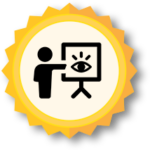Blended and Online Exam Proctoring
 Overview and Introduction: The WHAT and WHO
Overview and Introduction: The WHAT and WHO
Exam proctoring is not a new concept in education. In traditional face-to-face classrooms, exams are usually overseen by an authorized person (proctor) who ensures the identity of the exam taker and the integrity of the exam taking environment (time, place, restrictions). The same concept applies to blended and online courses, but the methods employed for proctoring may need to be altered to better address the unique needs of these courses, namely time and location.
There is a wide variety of digital proctoring tools and methods. The process can be as simple as starting a synchronous session via a web-conferencing tool. Or it can be as complex as employing artificial intelligence to flag violating behaviors that then alert live proctors to pop into the exam and counsel with the exam taker. Whatever process is used, one of the main things to consider is academic integrity in the virtual environment and what software, devices, or processes need to be in place to help ensure that integrity.
Benefits
The biggest advantage afforded students using online proctoring is the flexibility with regards to the time and location of the examination. Best practice is to allow students a 24 hour window to access the exam which usually has a set time limit once accessed. This allows students in various time zones as well as working students to take the exam at a time that works for them without having to drive to campus or a proctoring center.
Faculty also benefit from the flexibility of time and space. They no longer have to go sit in a classroom and stare at students as they take an exam. Depending on the setup, they can easily view exam data and violation reports from their office or at home, any time of day. Many processes require photo identification, room scans, webcam recordings, locked browsers and the like to help with assurances of academic integrity. If faculty do suspect a violation, there is usually video documentation and notes to help back up claims.

 Implementation and Timing: The WHEN, WHERE, and HOW
Implementation and Timing: The WHEN, WHERE, and HOW
Most online proctoring is only employed with ‘High-stakes Assessments’ (midterms, finals). Some of the reasons for this might be the cost of proctoring software, manpower to program proctoring, or the volume of data to analyze once students complete the exams. These tend to only be given at key points in the semester to provide student performance benchmarks. They are not usually repeatable, hence part of the need to ensure academic integrity.
‘Low-stakes Assessments’ (formative quizzes, homework, recitation activities, etc.) tend to be greater in number and spread throughout the semester in order to inform future learning and instructional resources. Students are meant to try, receive timely feedback, iterate, and eventually master these tasks. These tend not need proctoring as they are meant to be more of a learning tool involving examples and discussion rather than a snapshot of their achievement level.
If you plan on using online proctoring solutions in your course, there are a couple key locations you will want to locate some information in your course shell on the LMS.
Syllabus. Placing a statement about your use of a proctoring solution for exams. Many times instructors list the tool/process employed as well other pertinent information like technical requirements and resources for assistance with any tools needed. This helps present your expectations clearly to the students at the very beginning of the course and gives them a chance to ask questions.
Exam Module. It is a good idea to create an Exam Module in your course. This allows you to create one spot where students can access all they need to be successful in these typically high stress experiences. Common elements of this module are:
-
-
-
- Tool Info Page – overview information about the tool and process being used as well as where students can reach out for help.
- Practice Exam – this allows students to test the system/process before the actual exam. A practice gives them the chance to ensure their technology is set up correctly and that they know what to expect on the big day.
- Exam – time restricted and password protected utilizing desired proctoring solution(s).
-
-
Regardless of the proctoring solution you will be using, it is always a good idea to follow a few key practices.
-
-
- Place information about the proctoring process, tool and expectations in the syllabus.
- Create at least one Practice Exam/Quiz available early in the course. This exam/quiz does not have to contain content but should mimic the set up and rules all future assessments will follow.
- Create and program exams into Canvas at least a week ahead of time. This helps to reduce errors and allows for the leveraging of various resources like exam set-up assistance.
- Always review proctoring reports and address any concerns with students. If students feel you are not involved in the process, they may not take it seriously.
- Choose the right proctoring option for your course. Below are the options available at ASU:
- Campus & Hybrid Courses: Respondus Lockdown Browser or Zoom
- Fully Online Courses (I and O): Honorlock*
-
*Note: Honorlock can only be used in fully online courses and only for high-stakes exams such as midterms or finals. For formative quizzes throughout the semester, faculty can use Respondus Lockdown Browser. If you would like The FSE Learning & Teaching Hub or ASU Online to set up and manage the deployment of your exams within Honorlock, please fill out this digital form at least one week before your exam is due to launch.

 Rationale and Research: The WHY
Rationale and Research: The WHY
The rationale of using exam proctoring for blended and online courses centers on convenience and academic integrity. Students can conveniently take an exam at a location and time that best suits them. The typical exam window is 24 hours for fully online courses to allow working professionals to take it after hours. Regardless of the tool you use to proctor an online exam, one of the key elements many forget is follow-up. It is important to view and act upon the reports generated during the proctoring sessions to ensure academic integrity.

 Additional Resources and References
Additional Resources and References
Interested in learning more? Please read this ASU Knowledge Base Article: Online Proctoring Best Practices.